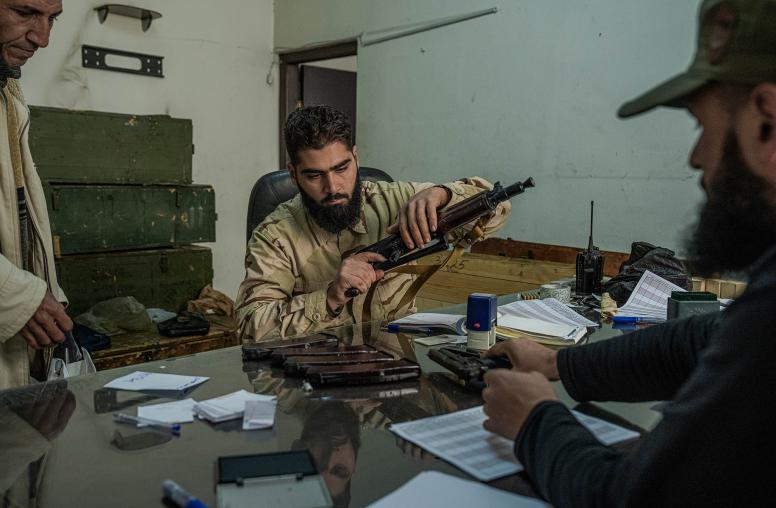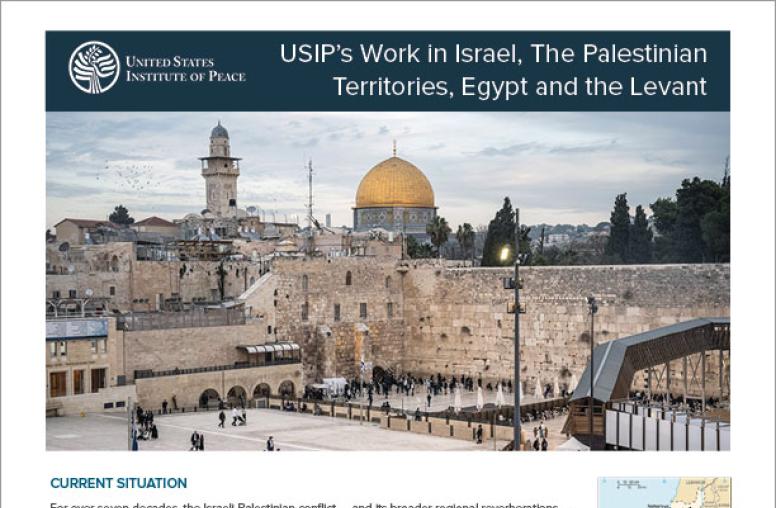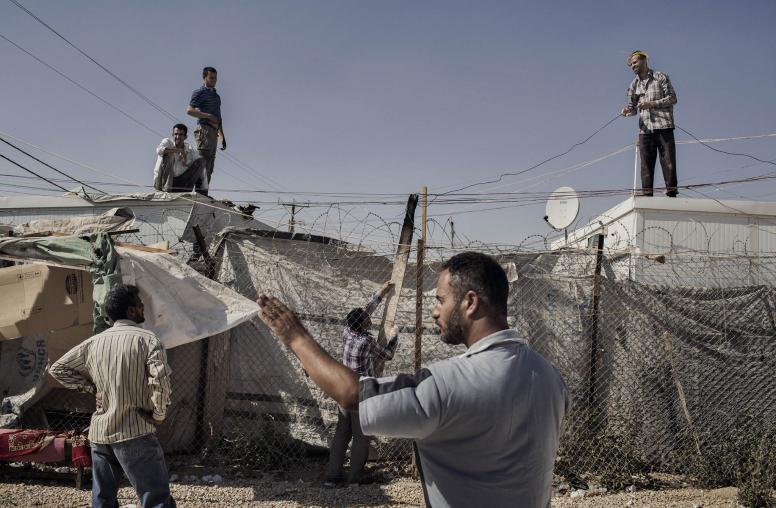Next Steps for U.S. Foreign Policy on Syria and Iraq
Testimony before the House Committee on Foreign Affairs Subcommittee on Middle East and North Africa
Dr. Steven Heydemann, vice president of the Center for Applied Research on Conflict at the U.S. Institute of Peace, testifies before a House Committee on Foreign Affairs Subcommittee on Middle East and North Africa.
More from Heydemann following his testimony, ”Integrated Iraq-Syria Strategy Needed to Defeat the Islamic State."

Good afternoon and thank you to the House Foreign Affairs Subcommittee on Middle East and North Africa Chairman Ros-Lehtinen, Ranking Member Deutch, and other members of the subcommittee for this opportunity to testify before you on U.S. policy toward Syria and Iraq. The views I express today are solely my own and do not represent those of the United States Institute of Peace, which does not take policy positions.
Toward an Integrated Syria Strategy: Summary and Recommendations
More than three years since Syria collapsed into civil war, and facing the most widespread violence in the modern history of the Middle East, the US still lacks a coherent, effective strategy to degrade and destroy ISIS, or achieve a political solution to the Syrian conflict. These goals cannot be achieved through policies that view ISIS and the Syrian conflict as separate. To paraphrase a great statesman, the US cannot fight ISIS as if there is no Syrian conflict, and pursue a political solution in Syria as if there is no ISIS. It must do both, and must put in place an integrated strategy for Syria that acknowledges the connections between the two. The recently announced review of Syria policy by the White House is a welcome recognition of the need for such a strategy. To be effective, the review should be guided by the following considerations.
- An integrated Syria strategy will require the US to expand its engagement with the Syrian opposition, improve prospects for a change in the balance of power on the ground, and help create the conditions necessary for a negotiated end to the conflict.
- Such an approach will require US support for a no-fly zone over northern Syria and a protected buffer zone along Syria’s border with Turkey.
- The proposed train and equip program for the Syrian opposition should be accelerated and its mission expanded to encompass both confronting ISIS and challenging the Assad regime.
- To ensure oversight and accountability for opposition forces trained with US support, and to strengthen Syrian alternatives to extremism and dictatorship, both the train and equip mission and the governance of a buffer zone should be linked to effective elements within existing Syrian opposition institutions.
From Bad to Worse: Deteriorating Conditions on the Ground
The options available to the US in Syria were poor in 2011, 2012, and 2013. They are worse today. US airpower has checked the expansion of ISIS but has not yet materially weakened ISIS’ position in either Iraq or Syria. Despite air strikes and support from Iraqi Kurdish forces and Free Syrian Army fighters, ISIS still controls significant ground in the border town of Kobani. Nor have airstrikes eroded ISIS’ appeal to new recruits, who continue to flock to its banner in record numbers. The US air campaign has permitted the Assad regime to expand its attacks on moderate opposition forces in Syria and tighten its siege of Aleppo, which may soon fall to the regime. It has further eroded views of the US among Syrian Sunnis and moderates, who, understandably, ask why the US has not used its air power to protect them from the violence of the Assad regime. US airstrikes have also provoked a backlash from Jabhat al-Nusra, al-Qaeda’s affiliate in Syria, which has attacked and defeated two of the moderate battalions in northern Syria that were viewed by the US as likely partners in its train and equip program. The moderate armed opposition, which has been steadily losing ground to extremist forces, is now a marginal presence in opposition-held areas.
These battlefield gains by Jabhat al-Nusra in northeast Syria and the possible, perhaps likely, fall of Aleppo to the Assad regime highlight the limits of a stand-alone train and equip program. Given the setbacks experienced by the moderate opposition, it is increasingly unclear how recruitment and vetting will proceed, or what the command and control structure for US-trained units will be. It is not yet clear to whom US-trained forces will report. Civilian authorities to which they will be accountable have not been identified. How the areas in which these forces operate will be governed has not been established. Nor have necessary connections been made between the train and equip program and the broader aim of US policy: to assist in creating conditions on the ground that will be conducive to re-launching negotiations and achieving a political settlement of the Syrian conflict.
Reassessing US Policy in Syria
The current review of US policy offers an opportunity to establish an effective, integrated political strategy for Syria. Given conditions on the ground, the relevant questions that the Administration’s review must address concern not only what can be done to degrade and destroy ISIS, but how US policy can help consolidate effective governance by moderate opposition actors in areas from which ISIS is cleared, retrieve the possibility of a negotiated settlement of the Syrian conflict, and assist Syrians in preserving a path between extremism and dictatorship—initially at the local level and eventually at the national level.
Developments on the ground in Syria, combined with the urgent threat posed by ISIS, amplify the costs of inaction for the US and for our partners in the region. These developments make it especially important that the policy review announced by the White House not become a missed opportunity. To avoid this will require moving beyond the policy of containment that has defined the US approach to Syria for the past three years. It will also require more than local ceasefires. Instead, the starting points for an effective US strategy need to include a clear understanding of the Assad regime’s role in fueling the rise of ISIS, and the recognition that US efforts to degrade and destroy ISIS will not be successful unless they are accompanied by a political framework that will move Syria toward a negotiated political transition based on the Geneva Protocol of June 2012.
The proposed train and equip program is an important piece of such a strategy. This should be placed on a fast track for implementation but also given a mission that extends beyond containing or rolling back ISIS to include operations targeting Assad regime forces. For the train and equip program to succeed, moreover, it must be accompanied by more extensive support from the US and its regional partners, including Turkey. It must be enabled through the establishment of a no-fly zone over northern Syria along the Turkish border, as well as a buffer zone inside northern Syria. Both a no-fly zone and a buffer zone should be supported by the active participation of a broad regional and international coalition. To ensure that appropriate accountability mechanisms and command and control structures are in place as fighters become operational it will also be necessary to link US-trained forces to effective elements within existing Syrian opposition institutions.
A no-fly zone and buffer zone will require a significant expansion of US engagement in Syria. Without them, however, the train and equip mission will be precarious, the effectiveness of US-trained forces against ISIS diminished, and the possibilities for a political solution to the Syrian conflict remote. With them, US-trained opposition forces will be able to operate from Syrian territory, with oversight provided by the opposition’s military and political leadership. Effective elements among the opposition’s political leadership and the interim Syrian government will be able to move inside the country. They will have the opportunity, once and for all, to earn the legitimacy they currently lack and persuade Syrians that their future is not limited to extremism or dictatorship. They will also be better positioned to support local councils and strengthen governance across opposition-held areas of the country. In addition, a protected buffer zone may offer Syrian civilians safe harbor from the violence of both the regime and jihadist groups.
Most important, the combination of a protected buffer zone and a better trained and better equipped armed opposition has the potential to affect the strategic calculus of the Assad regime, revive negotiations, and achieve a political transition that includes acceptable elements from the regime and the opposition and preserves institutions of the Syrian state. A protected buffer zone and well-trained opposition forces have the potential to upend the foundations of the Assad regime’s strategy, which rest on its conviction that the US and its partners are unwilling to engage on a scale that will affect the outcome of the conflict or threaten the regime’s future.
The Assad regime has been relentless in its pursuit of a military victory; secure in the support it receives from Russia, Iran, and Hezbollah, and persuaded that international assistance for the opposition will remain too limited to affect conditions on the ground. The integrated political strategy recommended here will challenge the core assumptions of the regime’s strategy, even as they provide the means to degrade ISIS, strengthen alternatives to extremism and dictatorship, and create meaningful incentives for both the regime and the opposition to negotiate a political end to the Syrian conflict.
Beyond Local Ceasefires: Retrieving a Geneva Process
Support for a strategy that includes top-down efforts to affect the strategic calculus of the Assad regime as a condition for re-launching negotiations has faded over the past year. The failure of Geneva II talks in January 2014, regime advances, and the rise of ISIS and other jihadist groups have dimmed interest in such an approach. The train and equip program, for example, has been presented as a response to the growing threat from ISIS. The White House has declined to characterize it in terms of its broader Syria policy, or as a counterweight to the Assad regime. More recently, proposals for local ceasefires have emerged as an alternative to an integrated political strategy. UN Special Envoy Staffan di Mistura has proposed a freeze for Aleppo. His intent is to bring relief to civilians who have endured enormous suffering and establish a model for bottom-up peacebuilding that might then spread to other settings. The Center for Humanitarian Dialogue in Geneva, in a plan yet to be made fully public, advocates a policy of local ceasefires on similar grounds.
Local ceasefires are a potentially positive step and warrant consideration. Measures that hold promise of an end to violence for communities that have endured years of devastating conflict should be pursued. Yet ceasefires are not an alternative to an integrated political strategy. They cannot resolve the deep differences between the Assad regime and its opponents that have sustained Syria’s conflict for more than three years. They have not been endorsed by any of the Syrian or regional parties to the conflict, either as a solution for Aleppo or as a general policy. Previous cases of local ceasefires have a mixed track-record, at best. And a strategy that rests on local ceasefires risks providing cover for a regime-imposed settlement that would expand support for extremist groups among Syrians opposed to the regime and undermine prospects for a broader political solution.
To prevent such an outcome, local ceasefires should be pursued in combination with an integrated Syria strategy designed to degrade and roll back ISIS, support the opposition in its efforts to change the balance of power on the ground, establish a no-fly zone and protected buffer zone, and help to create the conditions necessary for meaningful negotiations between the Assad regime and the Syrian opposition. Under such conditions the Geneva Protocol of June 2012, which remains the only framework for negotiation endorsed by the US, Russia, and other key stakeholder governments, can still provide a useful framework for a negotiated political transition that will end Syria’s devastating conflict and permit Syrians to begin the difficult and painful process of post-conflict recovery.
Thank you. I am happy to take your questions. The views expressed in this testimony are those of the author and not the U.S. Institute of Peace, which does not take policy positions.


